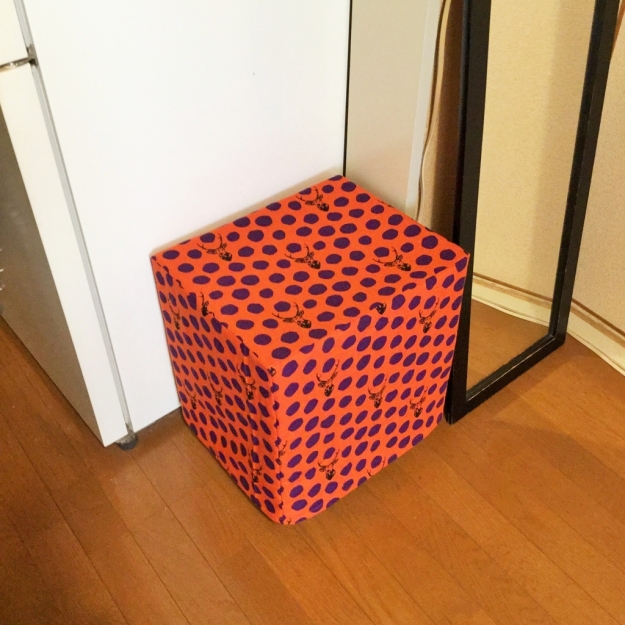
AW covering cloth for my cardboard composter


AW covering cloth for my cardboard composter
Among reusable alternatives for disposable feminine hygiene products, menstrual cups generally seem to be the most popular. But I prefer reusable cloth pads because I feel uncomfortable inserting a product into my body. Sure, washing thick blood-soaked pads is really a pain in the neck, but if you are able to avoid spotting in pads…?
A Japanese Peel Art artist, Shunko Saida, advocates the idea of Haikei 排経, which is a body technique to control menstrual blood. In plain words, our bodies can stop and let go of menstrual blood at will with vaginal muscle training. We can keep blood inside by tightening the exits when we don’t want it to flow out, and when we want to let it out, for example, when we are in a bathroom, we can open the gates.
Chizuru Misuna, a professor of epidemiology, also says in her books that all Japanese women in old times could do this because at that time underwear for women were skirt-like garments that had no crotch. They wore T-shaped loincloths while on their period but they had to be very careful to avoid leaking.
Misuna’s book that I read was totally a book of threats, saying that women who refuse their biological femininity (in other words, women who don’t give birth) will end up being Onibabas (Onibaba is an old Japanese female monster who eats humans). I think this denies diversity among the lives of women so I don’t agree with this opinion, but I do agree with her view that women should be more conscious about the potential of their bodies.
I myself am almost successful in this practice. It is not difficult in an inactive routine day. I just have to be mindful of that “I AM on my period”. To be more practical, when you stand up from a chair, tighten the muscles, and relax completely in a bathroom.
(On an active day, it is another thing. It was a total disaster the day I experienced a snowshoe activity for the first time in my life.)
By doing this, I manage to use only a pad for a day.
Moreover my “pads” are not in conventional disposable pad-like shapes. I use folded thin organic cotton cloths as pads. Their original shapes are simply square or rectangle, and this offers great flexibility. If I happen to spot on a pad a little, I can fold the cloth another way by tucking the spotted part in, and I can feel comfortable again after that.
And from the thin open weaved cloth, blood comes off easily after it is soaked in cold water for a while. It is better to add sodium sesquicarbonate, that dissolves the protein in the blood well. After that, just washing it in a washing machine with cold water is enough.
To prevent the pad from moving around, I wear period underwear with double crotch into which the wings of conventional disposable pads can be inserted. I just tuck both ends of my folded rectangle pad in.
You can by the cloth, Sunafu 素直布 here.
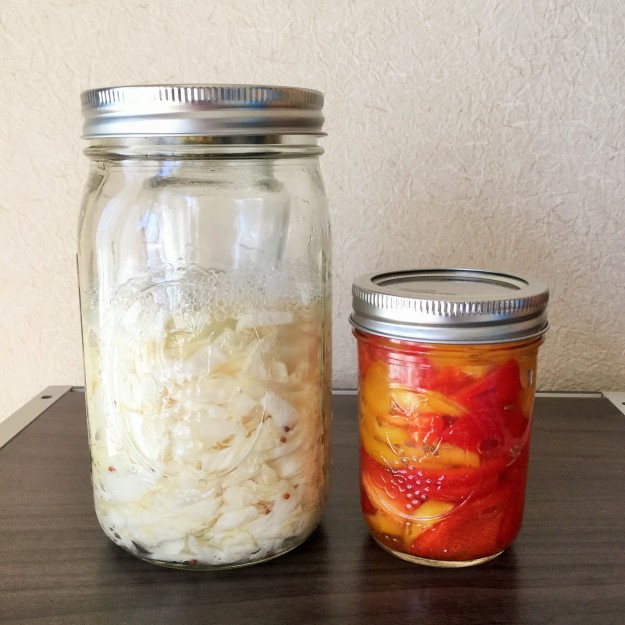
Now that my first composter is almost full, I bought a second kit from Hino City.
Instead of the kit, I could make one using a free cardboard box from a nearby supermarket, but I wanted to have one that is exactly the same in size as the first one.
Here are some photos and notes about the composter.
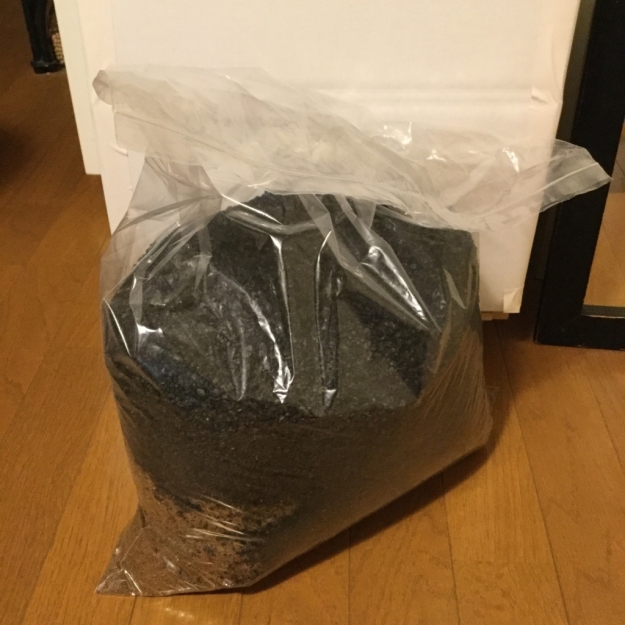 Initial materials: 9L of bamboo powder & 6L of sobagara-kuntan そば殻くん炭
Initial materials: 9L of bamboo powder & 6L of sobagara-kuntan そば殻くん炭
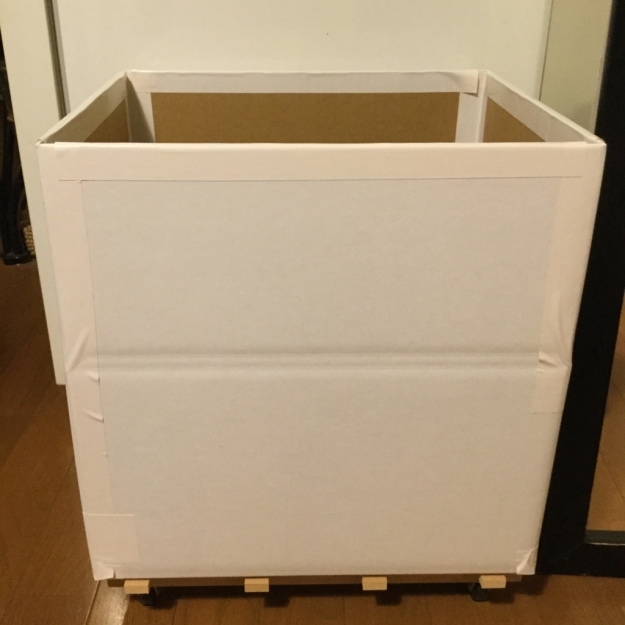 Size of the box: W370mm×H360mm×D300mm
Size of the box: W370mm×H360mm×D300mm
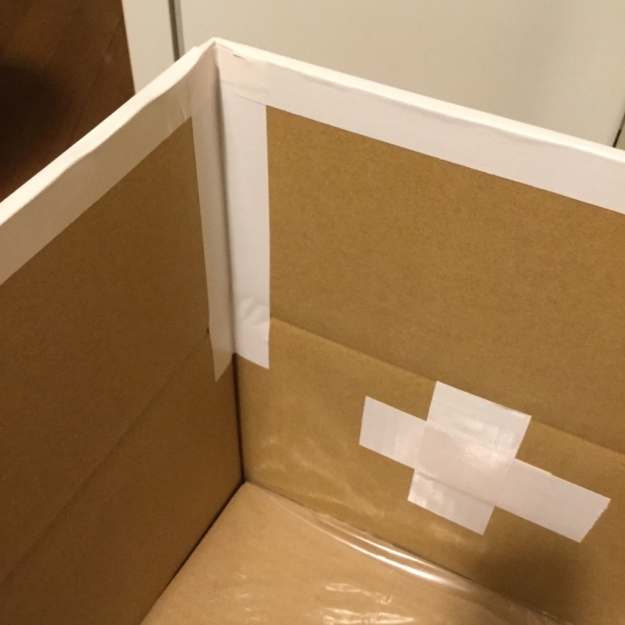 Handle holes are covered with tape from the inside.
Handle holes are covered with tape from the inside.
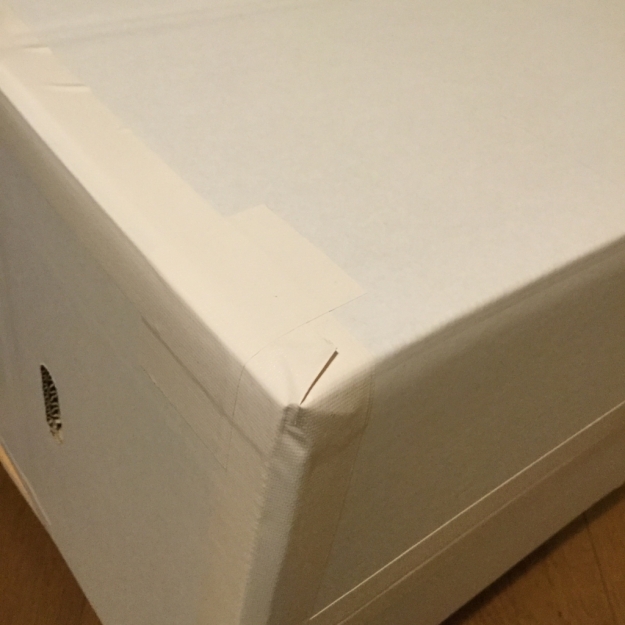 The corners are taped well to make the box sturdy.
The corners are taped well to make the box sturdy.
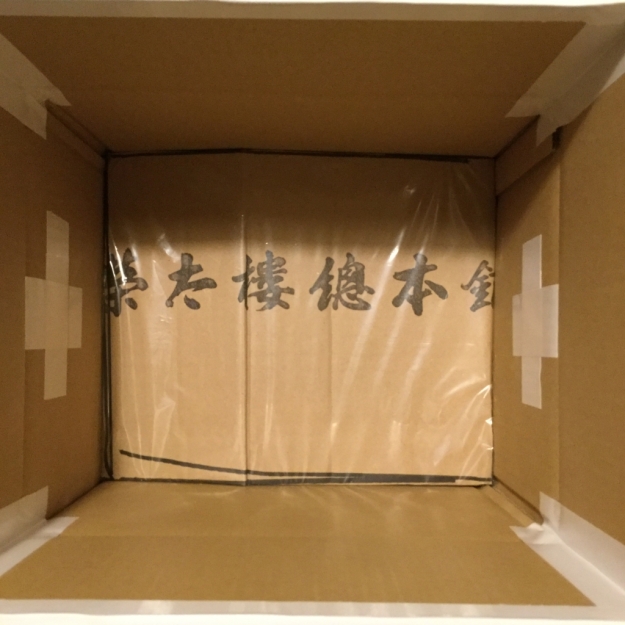 To double the bottom, the original box is lined with a rectangle-shaped piece of cardboard covered with a plastic bag 😦
To double the bottom, the original box is lined with a rectangle-shaped piece of cardboard covered with a plastic bag 😦
I think a wooden board would work equally well.
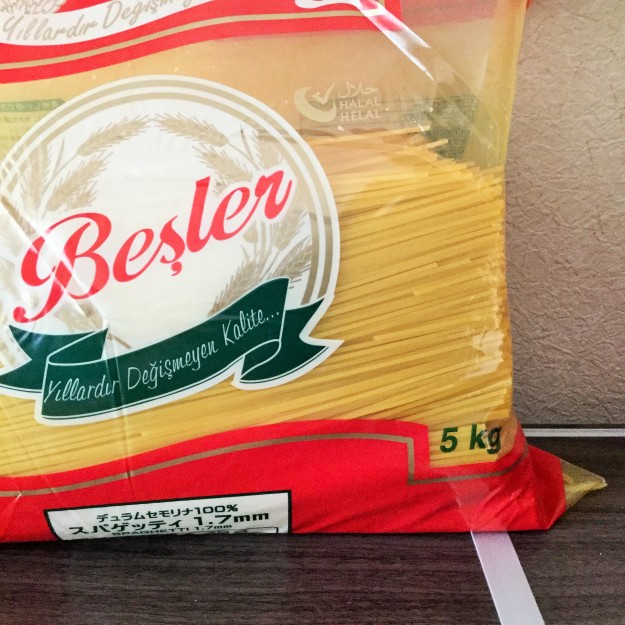
Bought a large bag of spagetti to reduce food packaging waste.
After sharing the post about the composting method that I’ve adopted on Facebook, I received some questions about where to get the initial materials, kuntan and bamboo powder.
So here is a follow-up related to the questions.
Momigara-kuntan (or Sobagara-kuntan そば殻くん炭) is quite a popular gardening material in Japan, so you can easily find bags of kuntan in big DIY and gardening stores.
For the bamboo powder, if you are lucky enough, you might find some in the same store where you get the kuntan, but I couldn’t find it at the stores in my area. So, for now, I have to rely on mail order to get bamboo powder.
Here are some web sites where you can order the bamboo powder from:
The most straightforward approach is to buy a starter kit that consists of a cardboard box and initial materials, as I did. I bought mine from Hino city, which is about 18 miles away from where I live. I also made my shopping trip an excursion to Takahatafudoson 高幡不動尊, so it was fun.
You can also buy a kit from an NPO, Junnamaken 循生研 through mail order if you live in Japan.
If you need more information, please let me know in the comments section.
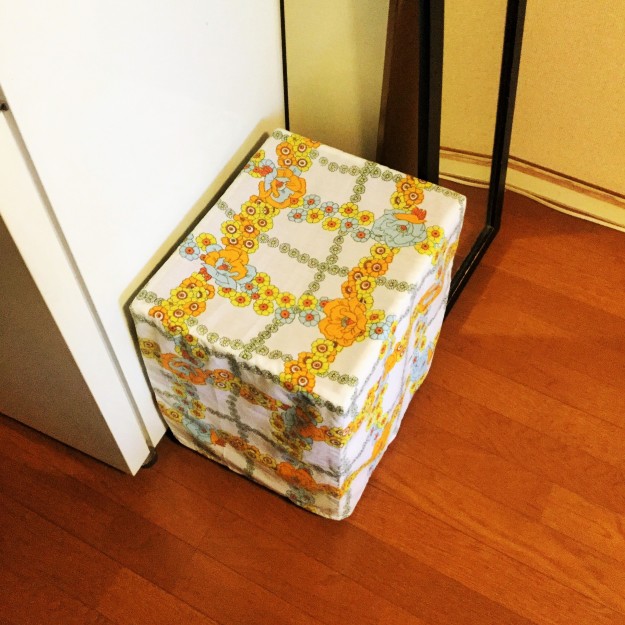
I have been composting using a cardboard box as a compost bin for about 4 months and found no trouble so far.
The composter has decomposed about 8 kilograms of kitchen scraps satisfactorily.
I wonder why, when it comes to composting indoors, almost everyone refers to vermicomposting and never to cardboard one.
Cardboard composting is very easy to handle with, no bad smells, no flies, and very little initial investment.
Everyone seems to think it is common sense that cardboard box should be IN a compost bin, but it actually works very well as a bin because it is well-ventilated. It adjusts the amount of water in the compost automatically. So you can put your kitchen scraps in it without draining.
What to prepare are:
A cardboard box with a doubled bottom
Alkali material and acid material
Something to put under the box to help ventilation (I use a small Sunoko)
Cloth to cover to prevent flies going in
For the alkali material, I use momigara-kuntanもみ殻くん炭, which is husk from rice smoked to be charcoal. Momigara-kuntan has many fine pores on its surface, which keep water, air, and microbes that decompose food put into the composter.
As for the acid material, I use bamboo powder. In the basic method of cardboard composting in Japan, they use peat moss as acid material, but peat moss is limited resource, bamboo powder is one of the sustainable alternatives. Bamboo powder contains many lactic acid bacterium and native microbes, also has many pores, and especially has a deodorant power.
If it is too difficult to prepare those 2 materials, I heard even only soil and rice bran will do (rice bran has many bacterium in it).
I put about 100g of veggie scraps and leftovers in it every day (you can put maximum 500g a day. And you can put not only veggie scraps but meat and fish unlike vermicomposter). The microbes are aerobic, so I mix the material well with a small shovel beforehand, dig a hole in the middle of the material (this is to avoid moist food scraps touching the cardboard directly), put food scraps in it, then cover it with some material. It takes about only 3 minutes or so.
This quickness owes to the factor that the composter is installed indoors. I’m a very lazy person. If this is outdoor, I can’t compost every day and my aerobic microbes wouldn’t work successfully as they actually do.
Living in a small apartment in an urban area and having no yard, I had no other choice, but now I’m very happy with this method.
As I mentioned above, vermicomposting seems to be what people consider first for indoor composting. But I was daunting. I don’t think worms are gross, of course. But I thought, I can’t be responsible for so many organisms, at least visible ones. I was also worried about runaway worms. What if I stamp them? This imagination made me terrified. At least my microbes are invisible, I feel easy at this point.
Everyday composting work is simply really fun. To my surprise, the scraps thrown in disappear completely in 2 or 3 days. And I also can feel confident that I can survive not relying on too much city convenience.
To tell the truth, at the beginning of my zero waste life, I had been lamenting that no compost service is available here, but now I’m having a second thought that I would not let others do this amusing work.
Worried about the durability of a cardboard as a zero waster?
Unless you mix materials roughly and tear the cardboard wall with a shovel, or unless you let wet things touch the cardboard, for example like tea grounds, it will be no problem. I’m thinking of using my current box for at least 3 years.
Many municipalities in Japan offer this type of composter, and even take back compost you made for their flowers at parks and sidewalks.
I highly recommend this method, if you are thinking of starting composting indoors.
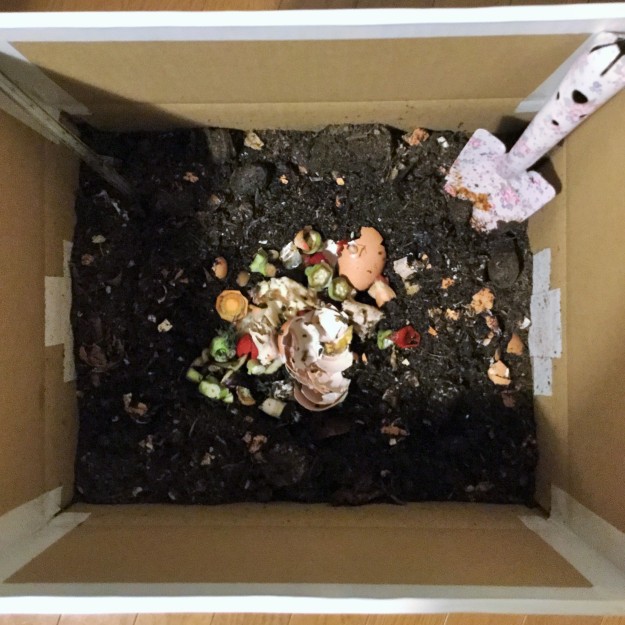
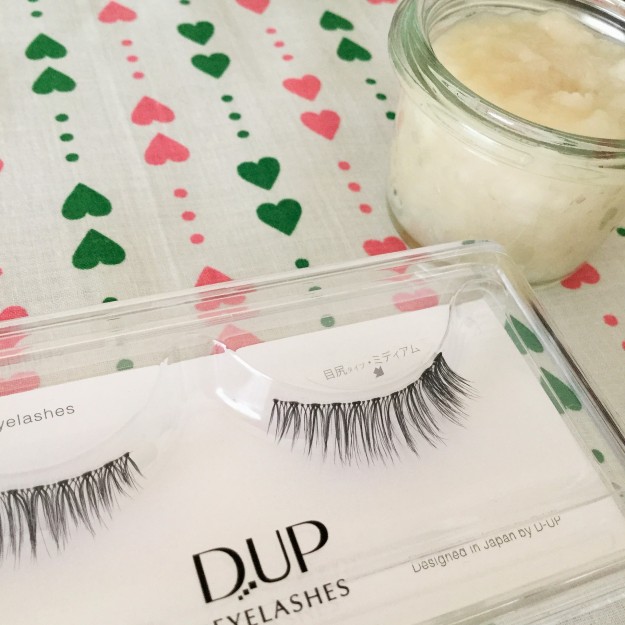
Thinking of replacing mascaras with fake eyelashes & homemade glue… not sure it would work though